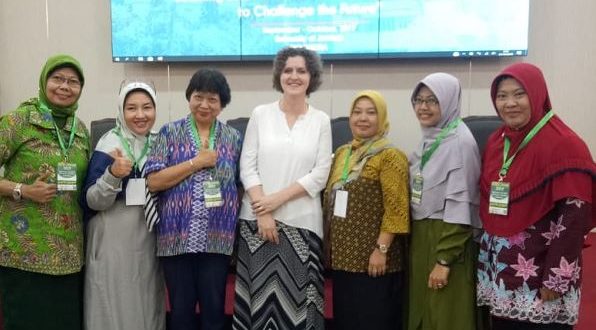Knowledge form The 1st International Confrence of Science, Technology, Engineering and Mathematics Education (ICoSTEM-Ed 2019) University of Jember
Jember, 1st October 2019
IPSE send one lecturer to attended the 1st International Confrence of Science, Technology, Engineering and Mathematics Education (ICoSTEM-Ed 2019) in Jember. The session consisted into two sessions, both presented STEM learning. The First session was presentation from Gillian Roehrig a Science Education in The University of Minnesota. She began her presentation with the fact that there is decreasing of young learners to like learning science in USA. The introducing of STEM learning in Minnesota aims to overcome this problem. STEM education supported by the government policy by launching Next Generation Science Standards in 2013 proposed to motivate students to learn science. In her presentation, Prof. Gillian identified the difference of STEM education apply in different country. For example, Korea apply STEAM and Japan stressed to the use of ICT in their STEM education.

The STEM learning in several Minnesota school begins with posing problems, followed by learn, Plan, Try, Test and Decide as it is showed in diagram below.

First step of STEM learning is the “problem statement”; students were asked to define the problem with facing to the questions: Who needs WHAT because WHY? From the question, they need to elaborate following questions:
- Who is the client?
- What does the client need?
- Why does the client need it?
- Who is the end of user?
- Why might the end used want it?
- What are the criteria and constrains?
The following step after the problem statement is “learn about the problem”. In this step students need to answer following questions:
- What kind of background knowledge is needed?
- What materials will be needed?
- What has already been done to solve the problem?
- How should we measure success and improvements?
The next step come to the “Plan”. In plant step, student need to plant for the solution by following these procedures:
- Generate Ideas for possible solution
- Develop multiple solution paths
- Consider constrains, criteria and trade-offs
- Choose a solution to try
- Develop plans
After making plan, come to the “try a solution”. Several actions must be done in this step, they are:
- Put the plan into action
- Consider risk and optimize work
- Use constrains criteria and trade-offs from plan to build a prototype model or product.
The step of “test a solution” is carried out after student try the solution. In this step student needs to:
- Consider testable questions or hypothesis
- Develop experiment or rubrics to determine if the solution is meet the stated criteria, constraints and needs
- Collect and analyze data
The lest step of the whole STEM procedure is “decide a solution”. In this step student needs to analyze these following question:
- Are users able to use design to help with the problem?
- Does the design meet with the criteria and constraints?
- How could the design be improved based on the test results and feedback from the client?
Prof. Gillian give several example of problems that might be raised for STEM teaching for students in Minnesota that can be found as a real problem faced by society in Minnesota.

The problem posed in STEM learning should be a real problem that is faced by the society. Prof. Gillian give several example of problems that might be raised for STEM teaching for students in Minnesota that can be found as a real problem faced by society in Minnesota.
One of the example is the problem of: “how can farmer start their farming soon after winter ends. Minnesota is a farming land areas where people life from crops. In Winter the temperature can reach to -40oC that make the farming land covered by thick snow (about 20-30 cm). When the snow melted the land will be flooded from the melting ice and that make farmer have to think of how to dry the land, so it will be ready to plan the crop very soon.
Another example of problem is about the pollution which occurred when the snow melted and the water go to the river as it can be seen in the picture.

The presentation from Prof. Gillian ended with answering the questions from the audience about the implementation of stem learning possible problems that might be raised for STEM learning in Indonesia which is elaborated in the second session by Prof. Dr. Indrawati from Jember University. [Dr. Diana Rochintaniawati].

